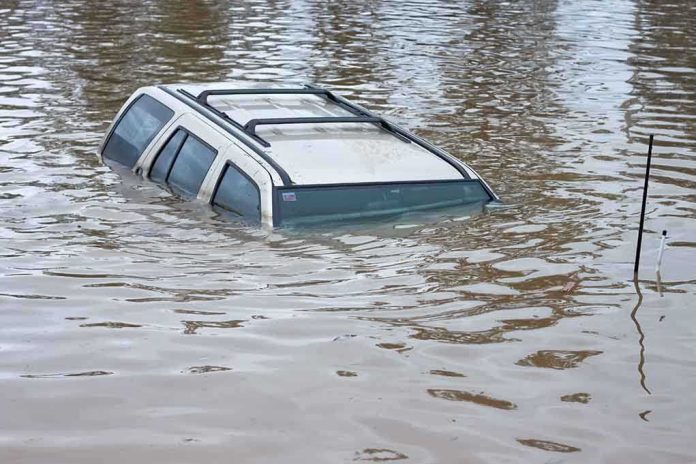
Foods delivered a catastrophic blow so severe that entire Mexican communities vanished overnight, putting the nation’s disaster response—and its future readiness—under an unforgiving spotlight.
Story Snapshot
- Simultaneous storms triggered historic floods across five Mexican states, killing at least 64 and leaving 65 missing.
- Over 250,000 people were affected, with infrastructure crumbling and communities cut off from aid.
- Emergency response struggled against overwhelming needs, sparking public frustration and political scrutiny.
- This disaster highlights the growing risks of extreme weather and the urgent need for systemic change in preparedness and infrastructure.
Floods Carve a Deadly Path Across Central and Eastern Mexico
October 2025 will be remembered for the relentless assault of tropical storms Priscilla and Raymond on Mexico’s heartland. Within a week, rivers in Veracruz, Puebla, Hidalgo, Queretaro, and San Luis Potosi surged from their banks, swallowing roads, homes, and livelihoods. Entire communities, some perched on precarious mountain slopes, found themselves isolated as landslides buried connections to the outside world. For many, rescue was a race against time—one complicated by crumbled bridges and impassable terrain.
While some urban centers weathered the deluge thanks to stronger infrastructure, rural and mountainous areas bore the brunt. In Hidalgo, families described waking to the roar of water as the river tore through their homes. In Veracruz, local officials reported supply trucks stranded miles from villages, with only helicopters able to airdrop critical food and medicine. Over 50,000 homes were damaged or destroyed, and at least a quarter million people faced urgent humanitarian needs.
Emergency Response Strains Under Unprecedented Pressure
President Claudia Sheinbaum assumed command of the national response, deploying more than 10,000 troops, aircraft, and emergency teams to the disaster zones. The National Civil Protection Coordination (CNPC) issued grim updates daily, confirming 64 deaths and 65 missing. Yet, the scale of devastation dwarfed available resources. Emergency shelters filled rapidly, and supply lines struggled to reach pockets of survivors. Public frustration mounted as isolated communities waited days for aid, prompting calls for accountability and faster action from federal and state leaders.
Relief operations were further complicated by relentless rain and destroyed infrastructure. Local authorities, already stretched thin, relied on volunteers and civil society organizations to deliver support where government resources lagged. Temporary shelters became lifelines for tens of thousands, but concerns grew over health, security, and the adequacy of long-term support. As days stretched into weeks, the disaster became not only a test of logistics but also a crucible for public trust in institutions.
Heavy rains flood Mexico towns, leave nearly 130 dead or missing https://t.co/ACGpnUWeKz https://t.co/ACGpnUWeKz
— Reuters (@Reuters) October 13, 2025
Climate Crisis and Infrastructure Vulnerabilities Exposed
The 2025 floods are not Mexico’s first brush with disaster, but the simultaneous impact of two powerful storms exposed deep-rooted vulnerabilities. Analysts and climate scientists drew direct lines between these events and global trends: warmer oceans, more intense storms, and rising rainfall extremes. Disaster management experts called for urgent investment in early warning systems, stronger infrastructure, and community-based preparedness. This crisis forced a reckoning with decades of underinvestment and the reality that climate-driven disasters will only grow more frequent and severe.
Economic fallout rippled across industries. Agriculture, a lifeline for many in the affected regions, suffered massive losses as crops and livestock were swept away. Local businesses shuttered, and the cost of rebuilding loomed large for families and governments alike. The insurance and construction sectors braced for a surge in claims and demand, while economists warned of long-term setbacks for already vulnerable communities. The specter of increased poverty and migration now haunts the recovery phase.
Political Fallout and the Push for Systemic Change
As rescue and recovery efforts continued, political leaders faced mounting scrutiny. President Sheinbaum and her cabinet promised comprehensive recovery plans and acknowledged public anger over the pace of aid. State and local officials demanded greater autonomy and direct funding for local emergency management, arguing that centralized systems had failed to deliver in the critical early days. Civil society groups and external volunteers emerged as critical actors, bridging gaps left by official channels.
Experts across the spectrum agreed on one point: without systemic reform, Mexico remains dangerously exposed. Calls for decentralization, international cooperation, and climate adaptation strategies grew louder. This disaster, more than any before, positioned climate resilience as a national security imperative. With the world watching, the choices made in the coming months will shape not only Mexico’s recovery, but also its ability to withstand the next inevitable crisis.









